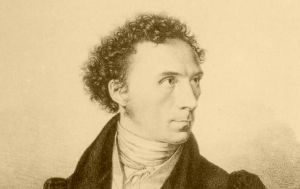

Theobald Boehm (1794–1881) was a goldsmith, engineer, and musician (both performer and composer). He pursued and made contributions in all these fields. In the late 1820's he (with Rudolph Greve) manufactured fine simple system instruments with eight or nine keys. About twenty years later (1847), we find him making all-metal flutes of a very different nature.
The Boehm flute used today all over the world is in many ways the same instrument that was created in 1847 in Boehm's Munich workshop. The net effect of his work was the overthrow of the design principles of the old flute (conical bore, closed-standing keys, six open holes under the fingers) and the institution of new, rational and logical principles (cylindrical bore with large holes in acoustically correct positions, open-standing keys, and a sophisticated mechanism). This was not just 'evolution', but 'revolution'. The result was almost a new kind of instrument. In fact, it was argued by some that the character of the Boehm flute was different—that it was no longer had the charm or effect of the 'true flute'. There would be much resistance to it in some places and by some individuals.
This revolutionary design change did not happen all at once. There were numerous experiments by Boehm and others over many years. Boehm freely incorporated available mechanical and acoustic ideas. But only Boehm had the courage to throw out the entire old system and start over—while at the same time having the engineering know-how to produce something that actually worked.
This is a survey of types and features of 19th century Boehm flutes. Development of the Boehm flute in the 20th century is beyond the scope of this web site and will not be considered here.
Boehm made his first flute, a four-key flute, in 1810. His Munich flute workshop was established in 1828. The simple system flutes he produced then were light and agile, had small holes, and had easy and bright high notes (rather like French flutes of the time had). He wrote virtuosic music for, and performed it on, these flutes. Click here to see excerpts from his composition Opus 4, Variations on Nel cor più, which was written for the simple system flute in the 1820's, several years before he resolved to design a new flute. Below is a simple flute by B. Pentenrieder (c.1840), another Munich maker, in a simple style which is almost identical to some flutes stamped T. Boehm; this is followed by the illustration, from Boehm's 1847 pamphlet Ueber den Flötenbau und die neuesten Verbesserungen dessleben, of a more sophisticated Boehm and Greve flute.


Boehm and Greve (Munich, c.1829),
simple system (9-key)
One would not know from his published music that Boehm was anything but happy with the flutes of the time. But he, like others, was well aware of certain deficiencies of the simple system flute: the unevenness or inequality of tone, the occasional difficulty of intonation, and the lack of volume.
It may in fact be the lack of volume that bothered Boehm most about the old flute. He performed in London in 1831 and his sound was compared unfavorably to that of the English virtuoso Charles Nicholson (1795–1837), whose powerful tone was said to resemble that of the organ. In a letter (dated 1871) to J. S. Broadwood, Boehm writes "I did as well as any continental flutist could have done, in London, in 1831, but I could not match Nicholson in power of tone, wherefore I set to work to remodel my flute. Had I not heard him, probably the Boehm flute would never have been made." (Nicholson's seven or eight-key flutes had large holes, enabling a larger sound, but this type of flute requires a powerful embouchure to control the unevenness in tone and intonation.)
By 1832, Boehm had come to believe in, and chose to implement (insofar as possible), a complete 'open(-standing) key system': all keys were to be off their holes until made to close by the player, and all holes beneath the sounding hole were to be open for the notes of the first two octaves. This is the way to get a loud, rich, and uniform sound. It was necessary to depart from this ideal in a few instances for the sake of practicality. Click for some technical comments on the new fingering and the imperfections of the Boehm system.
Boehm introduced his new flute in 1832 (after a preliminary and much simpler model was offered by the London firm of Gerock and Wolf in 1831). This instrument is the '1832 model', but that term is best avoided for conical Boehm flutes from later in the century, which differ in mechanism. The term 'ring-key flute', to mean conical Boehm flute, is still common.
The new flute had at first fourteen holes, twelve for the notes of the chromatic scale starting at d', a hole for the low c'# (the end of the flute served as the tone hole for the low c', of course), and a small hole for trills with upper note d'' or d'''. These holes were relatively large (except for the holes for c''# and d'') and located in their ideal places—not where the fingers just happened to be—the distance between the holes increasing slightly as they moved away from the embouchure. The correct positions and uniformity of size helped make the tone and intonation even; the larger size made the flute louder. These ideas were known before Boehm, but no one had incorporated all of them and made a practical instrument.




Shown above is an illustration of Boehm's 1832 model flute and three flutes similar to it. The Boehm and Rudall & Rose are in the Dayton C. Miller Collection at the Library of Congress. Shown below are three conical Boehm flutes from late in the 19th century.

It is not easy to see in the photographs, but the later flutes differs in mechanism in several ways (e.g. axles have been moved to one side, Bb thumb key added, modernized foot) from the 1832 model flutes.
Here is the illustration of the conical Boehm flute from Louis Dorus' L'Etude de la Nouvelle Flūte (Paris, c.1840), one of the very first method books for the new flute.

The Godfroy flute shown above, made shortly afterwards, matches this illustration very well. Compare, for example, the Godfroy foot joint with the illustration.


Boehm had to design a mechanism to allow the nine available fingers to govern the fourteen tone holes. This is where his engineering expertise was invaluable. His mechanism made use of ring keys mounted on rods or axles. (Keys mounted on sleeves rotating on post-mounted axles had already appeared on his earlier simple system flutes; see the illustration of the Boehm and Greve flute above.)
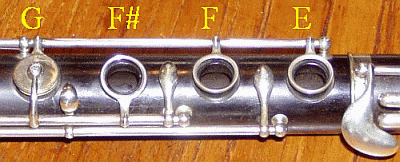
The ring keys serve to allow a finger to close two holes at once, both the hole surrounded by the ring key and another one further up the tube. The photo above shows the finger holes for the right hand on the early conical Boehm flute by Godfroy. There is also a hole under the key cup on the left (the F# key, over the G hole). The holes are labeled by the names of the notes they produce (when they are open and the holes above are closed). Three ring keys are visible, over the holes for RH1, RH2, and RH3. The key and the three ring keys are normally up, but when any of the F#, F, or E holes are covered, the F# key is automatically closed. The ring keys for the F and E holes are rigidly attached to the same metal sleeve that the F# key is mounted on, while the ring key for the F# hole transfers motion to the F# key with a vaulted finger-like lever which presses the middle of the key cup (over the G hole). See the photo above, and also see the photo comparing the Godfroy and Lot axles in the section on early modifications below.
In designing his mechanism, Boehm included one fingering for each note. He did not plan for the use of a multitude of alternate fingerings as advocated by flutists such as A. B. Fürstenau of Dresden. A very important goal for Boehm was simplicity of the mechanism. He intended the flute to be tuned in equal temperment and for the most part saw no need for sensitive fingerings.
In 1832, Boehm did not think about complicating the issues by significantly altering the bore from the conical type, with a cylindrical head, that had been in use for 150 years. So, in tone, his early flutes were not as far from simple system flutes of that time as one might think.
When the cylindrical Boehm flute was introduced in 1847, it was often adopted quickly by those already playing the conical Boehm flute. But conical Boehm flutes continued to be made and played, since some preferred their tone. The conical flute tends to have a sweeter and softer sound.
The conical Boehm flute received a boost in popularity when it was adopted by the Munich flutist Rudolph Tillmetz (1847–1915), a student of Boehm. Tillmetz been criticized by Richard Wagner after the premier performance of Parsifal in 1882; Wagner (who did not want his wind instruments to be loud) said Tillmetz' instrument (a cylindrical Boehm flute) sounded like a "cannon". As he explains in the introduction to his flute method of 1890, Tillmetz, after some experiments and contemplation, concluded that Wagner was right and as a remedy switched to the conical Boehm flute. He used instruments by J. M. Bürger like the one shown in the photo above. (Tillmetz was still known as a loud player. The writer finds that the Bürger flute can be quite loud.) Tillmetz, in 1890, praises the charming sound produced by the conical bore and also the quieter keys, which allowed elegant trills.
Leonardo De Lorenzo reports that on a visit to Munich in 1926 he "...was greatly surprised to learn that [Gustav Kaleve, a successor of Tillmetz], and in fact, most of the flute players in Munich, use the conical flute. They considered it more suitable and better adapted to chamber music, as it more nearly approached the flute for which the music was written." De Lorenzo relates that he personally did not agree with this.
After a period of pursuing other interests, Boehm again turned his attention to improving the flute in 1846. He was not completely satisfied with his 1832 model. He had concerns about the intonation in the third octave, which tends to be sharp. He still had ideas about increasing the volume of tone in the low notes.
In 1846–1847, Boehm studied acoustics with a Herr Prof. Dr. Schafhäutl in Munich and claimed that his 1847 model flute was founded upon scientific principles. We should understand 'scientific principles' here to mean logic and systematic experimentation, rather than any elaborate theories and formulas.
After numerous experiments, Boehm chose to use a cylindrical metal tube for the body. Below is the tube of a modern Boehm flute from which the keys have been removed.

The holes for C and D# are not visible, being on the side or under the tube, so we have indicated their size and location below.

The tone holes could be made larger on a cylinder (the tone holes on a conical body could not be larger than the bore), so large that they could not easily be covered by thin fingers. Boehm's very first model still used ring keys, but soon all holes were covered with solid key cups and pads (though ring keys occur sporadically for a few more decades).
The holes are still mostly uniform in size, and the space between them gradually increases as the holes move away from the top. The main exception is the C# hole at the extreme left, which is very small as it had to be put much higher than its 'scientifically correct position' for several reasons (e.g. it had to serve as a vent hole for the d'''). The resulting tone and sharpness of c''# remains one of the few defects on the Boehm flute. Otherwise, Boehm was pleased with the tone. It is flexible, but tends to be much richer, especially in the low notes, than the conical bore flute.
The octaves will not be perfectly in tune on a completely cylindrical flute. For an extreme example of this phenomenon, consider the renaissance flute. Because of its small diameter cylindrical bore and small tone holes, the octaves are very narrow. The a'' and b'' are so flat when one attempts to play them by overblowing the first octave that different fingerings must be used in the second. It is true that with larger holes and bore, as on many cylindrical ethnic flutes, and with proper cork placement and perhaps adjustments by the player, the first two octaves are pretty well in tune. But Boehm had to make a flute to play three octaves, because that is what the flute music of his time required.
Boehm's solution—to getting all three octaves in tune—was to put a taper in the head joint. This cannot be seen externally on a wooden head, but is evident on a metal head.

Boehm's prescription was to taper the head from 19 mm (the diameter of the body) to 17 mm at the cork stopper on the left of the embouchure hole. The taper is often described as 'parabolic'. But this is just suggestive of the shape. Every maker would use whatever curve they thought gave the best solution or compromise to the tuning problems, rather than following the exact equation that describes a precise mathematical 'paraboloid of revolution'. Even straight sides have been used, making the head a truncated cone.
Boehm's first cylindrical flutes were metal. (Metal tubes had been tried before, but not for full sized flutes.) The photos below were taken from a postcard from the Dayton C. Miller Collection in the Library of Congress.


Boehm and Mendler cylindrical flute (1877)
Notice that the mechanism of Number 1 (the tube is brass) is almost identical with that on Boehm's 1832 model.
Posts to support the rods and sleeves on which keys were mounted were usually just screwed into the wood on conical Boehm flutes. A method for attaching the posts that became common on cylindrical Boehm flutes was to solder the posts to 'ribs', which were then attached to the body of the flute (soldered to metal flutes, screwed into wooden flutes). These ribs can be seen in part in the following view of a wooden Boehm flute by Mönnig (Leipzig, c.1900).

Two-part tuning heads of the type used on simple system flutes are never found on cylindrical Boehm flutes because the taper in the head makes this impractical. Tuning a Boehm flute to a certain pitch can be done, over a limited range, by extracting the head joint a small amount, just as on any flute. This required no special construction on a metal flute; the tenon and socket between the head and body could be made fairly long and served as a tuning slide. On the wooden flute, an arrangement that may be called the 'French slide', where the tenon fit into the space between the lining of the socket and an inner metal tube, eliminates a gap in the inner wall when the head is extracted a small amount. We use this term because this arrangement was often used on French simple system flutes (but not on on other simple system flutes).
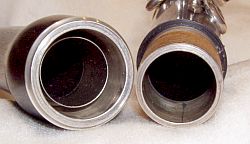
The Boehm flute resists adjusting to different pitch standards. In general, to change the pitch of a flute, one must adjust the hole spacing as well as the head joint length. (Players of the old flute were used to adjusting to correct intonation of various notes, and so they may have been more tolerant of changes caused by extracting the head joint.) In any case, some Boehm flutists today believe it best to have different flutes for playing at pitches as close as A=442 and A=440. Some 19th century makers attempted to make a Boehm flute play at two different pitches by providing two head joints, as shown below.

The two head joints on this flute differ in sounding length by 12 mm. With the different heads, the flute plays at close to the pitches A=452 and A=439 called 'old philharmonic pitch' and 'new philharmonic pitch' in London at the end of the 19th century. It is amazing that the flute works at both these pitches, although it does work better, especially in the extreme high notes, with the longer head joint. Perhaps the tapers in the head joints are somewhat different.
The cork stopper was essentially the same as on the old flute. The area in which the cork fits was cylindrical, so that the cork could be moved for tuning or cleaning. Boehm actually says that the cork should be removed after each playing session so that the head can be swabbed out. (No one does that today.)
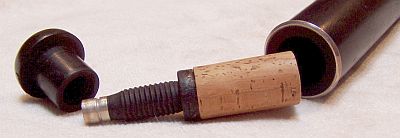
It was French and English players and makers who first took interest in the new Boehm flute. The 1832 system flute was manufactured by A. Buffet in Paris and C. Ward in London in the late 1830s, and in 1843 Boehm formally arranged that it be made by Rudall and Rose in London and C. Godfroy in Paris. (Boehm's own workshop was closed in 1839, as he had other concerns.)
Early innovations, included in Buffet's 1839 patent, were the addition of a trill key for trills with upper note d''# or d'''#, and the introduction of needle springs. Boehm had used only flat springs (leaf springs). The Godfroy flute uses both types. The photos show two needle springs on the Dorus G# key (see below) and a flat spring on the D# key.

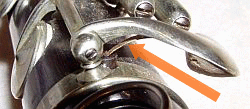
The needle springs facilitated the moving of all axles to the inner side of the flute. This Godfroy flute is still of the old style, with axles on both sides, but the later Lot (on the right below) shows the change.
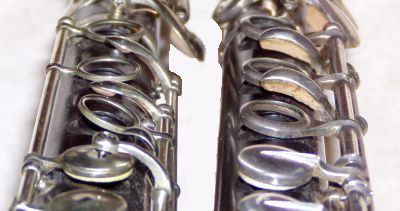
This move makes holding the flute more comfortable and secure. The ring keys on the Godfroy, for example, stand at different angles to the flute body, depending on which side they are mounted on, and this requires getting used to. The move to the inner side also eliminates the need for the delicate and easily damaged finger-like levers or 'vaulted clutches' that press into the centers of the Bb and F# key flaps. (These allowed ring kings mounted on one side to control key cups mounted on the other side.)
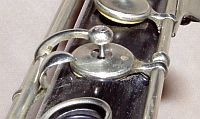
Boehm used one C hole (for c'' and c''') under the flute, but for some reason not really understood, the French makers began to use two smaller holes, both controlled by the same key. Two pads are visible on the B thumb key of the Godfroy, shown below. (There is no Bb thumb key on this instrument, or on Boehm's original 1832 model.)
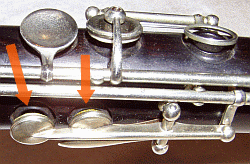
A significant modification to the open-standing key system was made by 1838. The Boehm flute required several changes in fingering. And among the changes was the fingering of G#. On the old simple system flute, the first three fingers of the left hand were placed on their holes, producing a G, and then LH4 pressed the closed-standing G# key to open a hole and raise the pitch. Because of Boehm's open key system, putting the first three fingers of the right hand down produced G#, and for the G, it was necessary for RH4 to press the open-standing G# key to close a hole. In part from simple prejudice by those who knew the old system, this reversal was seen as a serious impediment to facility and to adoption of the instrument. The Dorus G# key restored the closed G# key and the old fingerings of G and G#. The idea for this G# key (or, more accurately, G# key assembly) is due to Louis Dorus, who collaborated with Godfroy and Lot. The key appeared on Boehm flutes by Buffet by 1838.
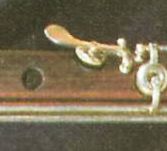
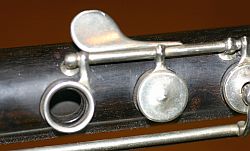
The Dorus assembly relies on two opposing needle springs (shown earlier). When well adjusted, the Dorus key works well enough. Closed G# keys (though usually of the 'duplicate G# hole' variety introduced c.1860; see below and here) have been in general use in France ever since, and are found on most of the flutes in the world today. A disadvantage of all forms of closed G# keys is that they require additional mechanism and damage the speech of high e''', unless extra additional mechanism is used to correct that problem. So it goes against Boehm's ideal of simplicity of mechanism as well as compromising the logic of the open key system.
The more modern foot joint construction seen on the Lot, Bürger, and Cloos flutes is already found in the 1850s.
The Briccialdi Bb lever, or key, allows the left hand thumb to finger Bb. R. S. Rockstro, in his treatise of 1890, states unambiguously that it was an invention of Giulio Briccialdi, and that it was first applied by Rudall & Rose in London to a cylindrical wooden flute made by Godfroy. But flute #0890 in the Dayton C. Miller Collection of flutes in the Library of Congress (shown near the top of this page) is a conical Boehm flute by Rudall & Rose stamped with the address that the firm used from 1838 to 1847, and it is equipped with a 'Briccialdi Bb lever', according to the library's documentation. There is always the chance that the device was added sometime after the flute was built, so Rockstro's story may be OK.
Boehm's fingering for Bb required the addition of RH1 to the B fingering (with LH1 and the thumb). This is sometimes called the 'one-and-one' fingering. With a Briccialdi lever, the left hand thumb can move slightly towards the head of the flute and that will close the B hole; it is not necessary to use RH1. In the photo below, we see the modern form of the Briccialdi Bb key at the Bürger flute on the bottom. An alternative form is seen on the Lot flute in the middle; the thumb is placed on the left touch to produce Bb, and the right touch to produce B. There is no Bb thumb key on the Godfroy at the top of the photo.
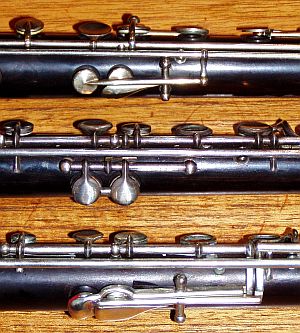
Boehm at first probably considered the Briccialdi Bb key unneccesary. It required extra mechanism. One Bb fingering was enough, he may have thought; one should learn to use that one. Still, Boehm and other German makers eventually recognized the utility of a thumb Bb key. They did not use the Briccialdi design, but contrived other thumb key assemblies. See the next section.
There are differences in the mature instruments made in Munich by Boehm and Mendler in the 1860's, 70's, and 80's, and those made in Paris by the Godfroy and Lot workshops during the same period. While gladly accepting improvements such as needle springs and a D# trill key, Boehm did not approve of those French modifications that seemed illogical or unnecessary to him, e.g. the closed G# key. Many makers took up manufacturing the Bohem flute later in the 19th century. The French manufacturers continued to favor the Lot model, while German manufacturers continued to follow Boehm's ideas. It will be convenient to distinguish two archetypes: the German model and the French model Boehm flute.

The German model (from e.g. the Boehm and Mendler workshop)—
This distinction between German and French models is an oversimplification (for example, Boehm produced many metal flutes and Lot many wooden flutes), but it will be useful as a basis for us to discuss certain mechanical features and differences. Nineteenth century English and American makers produced various styles of Boehm flutes, usually including options from both of these lists, so their flutes can be said to lie between these two extremes.
Most flute players around the world today play French model Boehm flutes.
The French model has a closed G# key. The Dorus G# key, however, was supplanted in the 1860's by another type of G# key that was found more reliable. The key for RH3 closes both the A hole and G# hole, producing G. A closed-standing key for RH4 may be pressed to open a second G# hole under the flute. This may be seen on the left below and here.
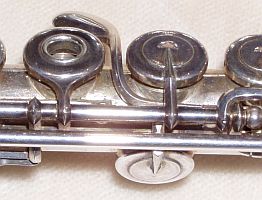
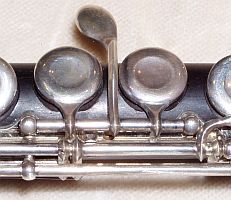
The French and English quickly adopted the Briccialdi Bb key. Boehm thought it was not logical, because the thumb moved up (towards the head) to produce a lower note. The photographs below show the Briccialdi thumb key on a French model flute and the thumb Bb key arrangements on two German model flutes. The assembly on the right is sometimes called 'reversed thumb keys' by those used to the Briccialdi arrangement; the thumb on the left touch gives B and on the right touch gives Bb.
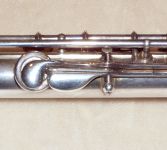
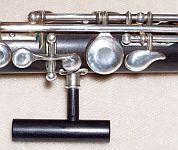
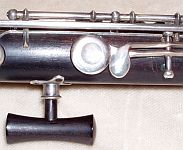
The arrangement in the middle, on the Mönnig flute, is the one Boehm himself prefered. Perhaps it seemed closer to his ideal of simplicity of mechanism. The thumb on the left touch gives B. For Bb, one must close the tear-drop shaped touch with the side of the thumb without releasing the touch of the B key; both must be pressed. (This is similar to the thumb keys on the Carte 1851 system.)
The writer prefers the reversed thumb keys, but has been told that the Briccialdi arrangement is mechanically more solid.
The key cups and pads of the German model flute are normal, solid flaps that let the finger cover the large holes. In the 1850's, French makers introduced key cups and pads that were 'perforated', i.e. had a hole in the center. These were used for the five keys where fingers (LH2, LH3, RH1, RH2, RH3) are directly above holes. These perforated keys might remind one of ring keys, but they had annular pads that covered a substantial amount of the hole whereas a ring key did not cover the hole. To fully close the hole under the key, one must press in the center of the key so as to close the perforation completely with the finger. Sealing the perforation with the finger requires some extra attention and effort. The advantage of the perforated key is that one can close just the rim, and perhaps part of the perforation as well, with the finger, and so thereby achieve some effects not otherwise available.
Today, flutes equipped with the two types of keys are often referred to as 'closed hole' and 'open hole' flutes. It is better to say 'French style' and 'plateau style' flutes or keys, since term 'open hole' is, when one thinks about it, silly and confusing, and it will not be used here. (Holes are always open... until covered.)
Shown below are the five perforated keys of a French model flute. (The orange arrow points to a side lever and the blue arrows point to French arms; these will both be discussed shortly.)

The perforated keys allow a number of alternate fingerings. French players of the simple system flute used a large number of sensitive fingerings to adjust pitch and timbre. This capability was lost to some extent with the Boehm flute because the large holes make forked fingerings ineffective and the keys made it impossible to partially cover a hole. The number of possible alternate fingerings, including sensitive fingerings, was greatly increased with the aid of the perforated keys. Altès gives a number of sensitive fingerings in his Grand Method (Paris, 1880) for the Boehm flute, many of which use the perforations in the keys. The majority of players today, though they may insist on playing French model flutes, seem not to use sensitive fingerings or make much use of the perforations at all. There are, however, notable players who do exploit the perforations.
Most if not all Boehm flutes have a 'side lever' to the left of the F# hole and operated by RH1 that is used to play B or A# (Bb). Boehm's 1832 model flute already had a similar lever, for B, but in a different place. This does not require much additional mechanism. Boehm's lever, and the side lever on German model flutes, closes the C hole and produces a B when added to the C fingered with LH1. Of course, one can also add the left hand thumb to the C fingering to produce B, but it was easier e.g. to trill C/B with the side lever, with its light spring. (There was a key for RH1 used for the C/B trill in about the same place on the simple system flute.)
The French chose to modify the side lever so that it closed the B hole and produced an A# (Bb) when added to the B fingering with LH1 and the left hand thumb. So it could be used for the B/A# trill. (But it is now used, in very many contexts, as a fingering for Bb.) Of course, one can also use RH1 on the F key to alternate B and A#, but it was easier e.g. to do this with RH1 with the side lever, with its lighter spring.
The G and G# holes are slightly 'offset' (moved somewhat out of line with the other keys, to the outer side of the tube) on German model flutes. This can be seen on the Meinell flute (but maybe more clearly on the Rudall Carte flute further down), while the G and G# holes on the Bonneville below are 'inline'.
For reasons of elegance and perhaps a little extra strength, the French enhanced the key 'arms' that join the key cups of the keys (those without perforations) to the sleeves with a finger-like projection that ends in a point in the middle of the cup.
A 'crutch' or thumb-rest was provided with a German model Boehm flute. This was thought to ease the left hand's role in supporting the flute so that the thumb and fingers could work more freely. Both the Mönnig and Meinell flutes have this. The crutch was wooden and T-shaped; one end fit into a holder under the flute and the base fit between the left hand thumb and first finger. Its use was optional. But outside of Germany it was often thought useless or even detrimental to freedom of the left hand.
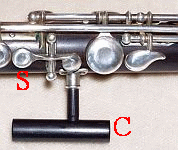
One extra bit of mechanism that Boehm felt worthwhile was the 'Schleifklappe' (whisper key, or sometimes octave key). It is seen above to the left of the B key on the side of the flute. The thumb could press the touch (while keeping the B key closed) to open a small hole (at 'S' above) which would act as a vent hole to improve the speech or intonation of a few notes. On this flute, the writer finds it does very slightly sharpen the d''', which can tend to be flat on some Boehm flutes; it makes it easier to play d''' piano. On other notes like e''b and e'''b on which Boehm recommended its use, it seems to have no discernable effect.
The most important 19th century English manufacturer of Boehm flutes was Rudall Carte & Co. (earlier Rudall & Rose, then Rudall Rose Carte & Co.). Rudall Carte shipped instruments all over the world, especially to America, Australia, and New Zealand.
Below is a Rudall Carte cylindrical Boehm flute. It has a closed G# key, offset keys, Briccialdi Bb, and a side lever for B.

The English continued to prefer wooden flutes until the middle of the 20th century. Some of Rudall Carte's wooden flutes, like this one, were provided with 'thinned heads'; the wood was turned down so that the taper in the head joint is visible. The head joints were metal lined, so the head remained strong. Some players might prefer the balance of a flute with a thinned head.
The most important 19th century American manufacturer of Boehm flutes was Alfred G. Badger. Below is a cylindrical Boehm flute by Badger, in silver. It has a closed G# key, inline keys, Briccialdi Bb, and a side lever for B.


Badger was involved in making conical Boehm flutes by c.1845, and made cylindrical flutes after 1847. He worked primarily in silver. Many of his flutes have two head joints, the second head joint being ebonite but of the same pitch as the silver head joint.
A number of flutes by Badger have a Bb-foot, as this one does. The touch of the low Bb (A#) key is given to LH4 and can be seen on the left of the photo below, next to the G# key.

The American poet Sidney Lanier was interested in flutes with extended low range and collaborated with Badger (who also published some of Lanier's music). Lanier's Wind Song for unaccompanied flute has several low A#'s, and the above flute by Badger is one of the few Boehm flutes that can play it without changes.

(The low Bb's appearing in some symphonies of Mahler were surely intended for long Viennese simple system flutes, where this Bb extension was not rare, and not for Boehm flutes. I don't know of any 19th century German Boehm flutes with a Bb foot.)
Badger's flutes are very fine, the equal of any European flutes. They all seem to be pitched very high, about A=455, and have fallen out of use since they cannot be played at modern pitch. Perhaps this is why too few know his name today.
Unlike Badger, most American makers in the late 19th century made Boehm flutes of wood, and mostly in the German style. Many flute makers, like Meinell, were German immigrants. The dominance of the German model flute in wood changed after the immigration of several eminent French flutists at the turn of the century. A booklet published in 1925 by the Haynes firm states "A few years ago, the Wm. S. Haynes Company was constructing ninety-nine wooden flutes as opposed to one of silver. During 1924 the output of the company was 100% silver."
It is a mistake to assume that the flute sound of the second half of the 19th century was that of the Boehm flute just because the instrument originated before then. The speed at which the Boehm flute spread depends what locations and context we are talking about. If one means professional circles in Paris, one might say Boehm flute spread relatively quickly. If we consider e.g. professional dance bands, or even many major orchestras in Germany, we should say the Boehm flute spread slowly.
One should not forget that the Boehm flute was very expensive in the 19th century. It is true that the fanciest simple system flutes cost about as much as a Boehm system flute from many manufacturers c.1900, but one could obtain fine professional quality old system flutes (just not so fancy) for much less. See the prices in old catalogs.
The change to the Boehm system in Paris was indeed relatively quick. By 1860, the Boehm flute had been adopted by the Paris Conservatoire. J.-L. Tulou (1786–1865), a staunch defender of the old system, had retired the previous year and Louis Dorus (1812–1896) had taken his old position. The French model flute (see above) in silver is strongly associated with the `French Flute School' that begun with Dorus and his student Claude Taffanel.
The Boehm system had a tremendous influence in London. As described elsewhere, it motivated the introduction of numerous 'hybrid systems' (Carte's system, Radcliff system, etc.) and 'improvements' (e.g. Rockstro's model). The Boehm flute and the cylindrical bore hybrid systems sounded pretty much the same, and were all considered 'modern flutes'. By the 1860's, all important London flutists were playing modern flutes.
In 1889, R. S. Rockstro seems to indicate that Boehm flutes were rare in Germany, while complaining about the variants in use in England: "In justice to the consistency of our Continental neighbours it should be mentioned that while we [the English] have been too prone to vacillation between the old, the new, and the pseudo-old systems, the French have been generally loyal to the [Boehm flute]..., and the Germans have, with equal pertinacity, adhered to the old flute, pure and simple."
The resistance to the Boehm flute in Germany is explained by W. S. Broadwood, in the introduction to the 1882 English version of Boehm's pamphlet (Essay on the Construction of Flutes): "...certain German conductors appear to have considered that the Boehm flute does not take its proper place in the graduation of 'wood' instruments, which, commencing with the bassoon, culminates in the piccolo. In power and breadth of tone, sometimes also in quality, it approaches too near the clarinet to give the balance of tone, which writers—like, for instance, Mozart (whose minute appreciation of the characteristics of each instrument is very striking)—would seem to have aimed at."
Leonardo De Lorenzo relates several anecdotes that imply the Boehm flute was not common in at least some parts of Italy circa 1900. For example, he studied composition with a Maestro De Nardis at the Naples Conservatory, who expressed a wish to hear his flauto moderno, De Lorenzo says, since the maestro had never seen or heard a Boehm flute (this was in 1907).
In 1906, Adolph Goldberg, a Berlin silk hose millionaire and flute enthusiast, privately published a collection of photographs of flutists. Originally on cards, the collection was reprinted in book format by Moeck in 1987 as Porträts und Biographien hervorragender Flöten-Virtuosen, -Dilettanten, und -Komponisten. Only about 30% of the 409 flute players are depicted holding instruments, but it would appear from this collection that—by 1906—the Boehm flute was well on its way to eclipsing all other systems among orchestral flutists. We will report on this collection in greater detail elsewhere. Only flutists working in Germany and Eastern Europe (disregarding two old players) hold conical flutes in the photographs (twelve simple system flutes and six reform flutes). But even in those regions, one finds more Boehm flutes; a quick count yields 36 Boehm flutes, 31 wood and five silver. Use care about concluding too much from this collection, however. We do not know how Goldberg chose the photos and whether this is a truly random sample of flutists. Goldberg himself was a Boehm flutist and that he presented examples in gold to several distinguished performers he knew and admired.
Thanks to Susan Maclagan for suggestions about exposition on this page.
